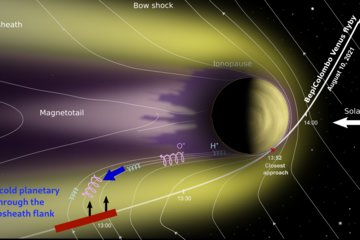All genres
81.
Journal Article
Modelling the Sun's open magnetic flux. Astronomy and Astrophysics 459, pp. 945 - 953 (2006)
82.
Journal Article
Magnetoconvection in a sunspot umbra. Astrophysical Journal 641 (1), pp. L73 - L76 (2006)
83.
Journal Article
The solar magnetic field. Reports on Progress in Physics 69, pp. 563 - 668 (2006)
84.
Journal Article
A necessary extension of the flux transport model. Memorie della Societa Astronomica Italiana 76, pp. 933 - 936 (2005)
85.
Journal Article
Flux tubes, surface magnetism, and the solar dynamo: constraints and open problems. Astron. Nachrichten 326, pp. 194 - 204 (2005)
86.
Journal Article
Is there a phase constraint for solar dynamo models? Astronomy and Astrophysics 439, pp. 749 - 750 (2005)
87.
Journal Article
The dynamical disconnection of sunspots from their magnetic roots. Astronomy and Astrophysics 441, pp. 337 - 346 (2005)
88.
Journal Article
Mechanisms of secular magnetic field variations. Mem. S.A.It. 76, pp. 781 - 788 (2005)
89.
Journal Article
How unusual is today's solar activity? (reply). Nature 436, pp. E4 - E5 (2005)
90.
Journal Article
Solar activity, cosmic rays and Earth's temperature: A millenium-scale comparison. Journal Geophysical Research 110, p. A10102 (2005)
91.
Journal Article
Simulations of magneto-convection in the solar photosphere: Equations, methods and results of the MURaM code. Astronomy and Astrophysics 429, pp. 335 - 351 (2005)
92.
Journal Article
Evolution of the large-scale magnetic field on the solar surface: a parameter study. Astronomy and Astrophysics 426, pp. 1075 - 1091 (2004)
93.
Journal Article
The Sun - a ball of electrically well-conducting gas. inSIDE - Innovatives Supercomputing 2 (1), pp. 4 - 5 (2004)
94.
Journal Article
On the origin of solar faculae. Astrophysical Journal 607, pp. L59 - L62 (2004)
95.
Journal Article
Kelvin-Helmholtz and shear instability of a helical flow around a magnetic flux tube. Astronomy and Astrophysics 420 (2), pp. 737 - 749 (2004)
96.
Journal Article
Distribution of magnetically confined circumstellar matter in oblique rotators. Astronomy and Astrophysics 417, pp. 987 - 992 (2004)
97.
Journal Article
Does the butterfly diagram indicate a solar flux-transport dynamo? Astronomy and Astrophysics 421, pp. 349 - 351 (2004)
98.
Journal Article
G-band spectral synthesis and diagnostics of simulated solar magneto-convection. Astronomy and Astrophysics 427, pp. 335 - 343 (2004)
99.
Journal Article
Unusual activity of the Sun during recent decades compared to the previous 11,000 years. Nature 431 (7012), pp. 1084 - 1087 (2004)
100.
Journal Article
Reconstruction of solar activity for the last millenium using 10Be data. Astronomy and Astrophysics 413, pp. 745 - 751 (2004)











